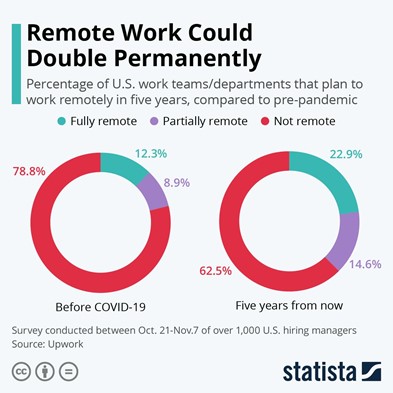Remote work
Remote work refers to a new working style in which employees work outside the company’s physical office or anywhere owned or assigned by the company. In this work arrangement, employees don’t have to come to the office at all. They can be successful wherever they decide to do their jobs. This allows employees to have more personal free time and spend more time with their family. NASA engineer by the name of Jack Nilles in the 1980s was the first person to do remote work, otherwise known as “telecommuting.” There was no Skype or Zoom back then, but it didn’t hinder him from finding success in the said work arrangement. After that, it spread around the world and resulted in the birth of a new word: satellite office.
Advantages of remote work
For workers:
Working from home has three big advantages:
- It allows for great work-life balance.
- It gives employees more family time.
- It is less stressful, as the employee is not obligated to report at the office.
For companies:
Remote work is also beneficial for companies. It offers three advantages.
- It allows them to save money, as it costs less to make the employees do their jobs.
- Remote work improves the company’s corporate branding image.
- Because most employees prefer that kind of work arrangement, employee turnover is prevented and human resources are secured.
Disadvantages of remote work
For workers:
Remote work has three downsides.
- There could be insufficient communication among employees and between the company and the employees.
- It is hard to judge when the work will be completed.
- Employees may find it difficult to concentrate on work because of distractions.
For companies:
Telecommuting may be disadvantageous for companies because:
- it is difficult for the company to manage employee attendance;
- it is hard to gather the employees together in the same place; and
- it is difficult for the company to monitor work progress.
The future of remote work
Percentages of remote work before and after the pandemic

The charts explain how remote work has changed since before COVID-19 and will change five years from now.
Pre-COVID, almost 80 percent of companies didn’t accept remote work, and only 20 percent of companies had some remote work options. Especially, the said 20 percent of companies are internet technologies. During COVID-19, most companies have accepted remote work, which started when lockdowns were implemented, and in five years, 37 percent of companies are expected to be accepting remote work.
References
Apollo Technical LLC. 2022. Statistics On Remote Workers That Will Surprise You (2022) – Apollo Technical LLC. [online] Available at: <https://www.apollotechnical.com/statistics-on-remote-workers/> [Accessed 22 April 2022].
Remote Year. 2022. What is Remote Work?. [online] Available at: <https://www.remoteyear.com/blog/what-is-remote-work> [Accessed 22 April 2022].
Crossover.com. 2022. Crossover. [online] Available at: <https://www.crossover.com/perspective/the-history-of-remote-work> [Accessed 22 April 2022].
Spica.com. 2022. Remote Work – Advantages and Disadvantages | Spica. [online] Available at: <https://www.spica.com/blog/remote-work-advantages-disadvantages> [Accessed 22 April 2022].
